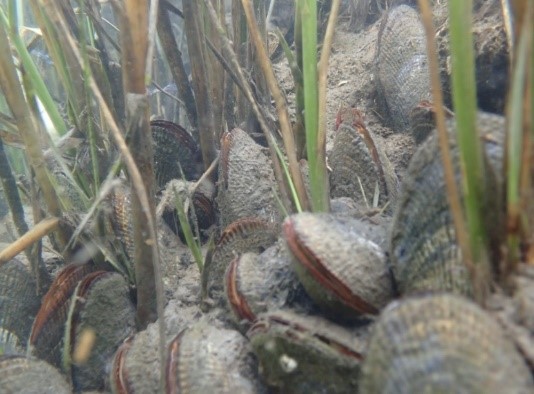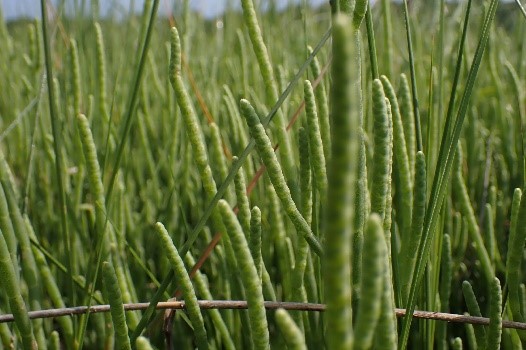
Facebook Twitter Instagram YouTube
Written on: September 8th, 2021 in Education and Outreach, Wetland Animals
By Kayla Clauson, DNREC’s Watershed Assessment and Management Section
If you’re anything like me and always looking for an adventure, maybe you should check out a tidal salt marsh! I’ll admit – I am slightly biased towards salt marshes due to my professional background, but I’ve exposed many individuals to the wonders of a salt marsh and it always ends up being an exciting trip.
Not only are tidal salt marshes amazing because of their important ecologic services, they are very aesthetically pleasing. Whether you enjoy birding, hiking, exploring, or just getting outside – a salt marsh might be a fun next adventure for you.
Here, I’d like to break down salt marshes for the five senses when you plan on visiting one.
First thing, smell:
I’ll just say it – smell will probably be least favorable on the senses when it comes to visiting a salt marsh. If you’ve ever been outside and stopped to smell the fresh air and instead get a whiff of rotten eggs…chances are you’ve smelled a salt marsh already. This smell happens because the marsh itself is situated on multiple layers of decaying plant materials, called peat. Bacteria that are decaying the dead plants use up a lot of oxygen in the process, creating low oxygen, or hypoxic, sediments. The remaining gas after the decaying process is called hydrogen sulfide – hence the rotten egg smell in the air.
The smells of the marsh vary, and don’t always smell of rotten eggs (unless I’ve gotten used to it at this point). Chances are if you’re in a salt marsh you will experience a mixture of earthy smells, including salt and mud.
Next up, touch:
If you were to walk out into a salt marsh and jump, you’d be quite surprised how that feels*. If you jumped on it, you would feel the hollowness of the peat when you land vibrate through the marsh. It feels very different than jumping on the grass in your backyard or local park. Salt marshes are very spongy, which is why they are so important in protecting us against storm flooding- they soak up excess water before it reaches our homes. If you had a handful of peat and squeezed it like a kitchen sponge, water will fall out!
Let’s talk about hearing:
Over the noise of your feet splashing in the creek or sucking into the mud, you’ll hear a suit of bird noises. Common birds you may find year-round are self-explanatory based on their common names, including Salt Marsh Sparrows and Marsh Wrens. There are other common birds that make the marsh a noisy place, such as Willets, Osprey, and Red-winged Blackbirds to name a few.
There’s also lots to see:
Because they are such an important habitat for wildlife, there is a lot you may encounter when visiting a salt marsh. If you’re looking in the water of a tidal creek, you may find small shrimp, crabs, fish, snails, and horseshoe crabs. As you look outward from the water you will see Fiddler Crabs and their burrows hidden among the Ribbed Mussels and low marsh plants, like Saltmarsh Cordgrass. As you look further outward towards the high marsh, you will see the vegetation shift from Saltmarsh Cordgrass towards the shorter, flatter Saltmarsh Hay. Some mammals including White-tailed Deer, Raccoon or even Mink, may be seen foraging in the marsh.


If you get the chance to observe the variety of salt marsh plants closely, you may see some of them sparkling. This isn’t because they are covered in glitter, rather they are masters of their harsh saline environment and can excrete the salt from the water onto the blades of their leaves.
Best for last, taste:

As ironic as it may be, one of my favorite snacks can be found in the salt marsh! Commonly known as Seapickle, the succulents of Salicornia spp. are often found in the low marsh and are a crunchy, salty snack. If you’re not into eating plants, Blue Crabs might be more appealing to eat due to its savory and tender meat. Blue Crabs are very reliant on tidal marshes for life-cycle development. However, you should cook them first!
A mistake one might make when looking for tasty snacks in the salt marsh is attempting to eat Ribbed Mussels. These bivalves do not taste as good as the popular Blue Mussel because of the high concentrations of sulfur they filter from the marsh. However, you may be able find other tasty bivalves, such as Oysters or Hard Clams, around a salt marsh in deeper water.
To wrap up:
Now that you’re prepared for some of the senses you will experience in a salt marsh, you may want some packing tips for your visit. I recommend:
* Helpful hint: I do not recommend walking around in a salt marsh, they can be tricky places if you’ve never done it before! Instead, try visiting an educational facility with trails to experience the marsh. Some great marshes to visit are at St. Jones Reserve or Bombay Hook